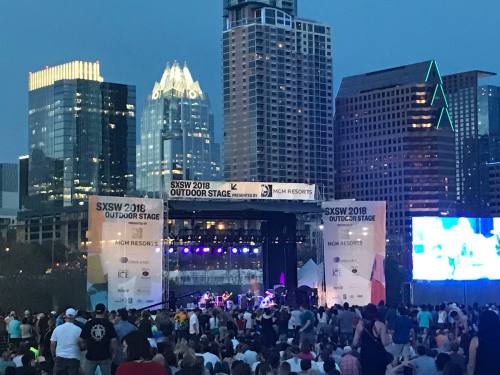While South by Southwest Conferences & Festivals brings profits to bars, restaurants and hotels downtown, it presents a different set of challenges to South Austin businesses.
Kelly Chappell, owner of Top Notch Hamburgers, Zocalo and local chain Galaxy Cafe, said the annual 10-day event that draws tens of thousands of visitors to the city disrupts regular business at his South Austin location of Galaxy Cafe. When he opened the restaurant at the corner of Brodie and Slaughter lanes in 2004, he staked his financial success on attracting steady business from locals.
“We don’t keep our regular business and add to it when SXSW comes into town,” Chappell said. “It’s a wash for us. And it’s logistically more difficult.”
Citywide, SXSW reports an enormous impact on Austin—to the tune of $350.6 million in 2018—according to a report by Greyhill Advisors, a firm hired by SXSW to develop economic impact reports since 2011.
With increased traffic, an influx of visitors and skyrocketing prices, SXSW is more than a 10-day hiccup downtown. It mirrors the changes the city of Austin is experiencing as its population, economy and tech sector continue to grow.
A barometer for change
In 1987, when SXSW started, it was a local stage for undiscovered musicians in a city of just over 461,000 people.
Now, 32 years later, SXSW is an internationally known music, film, gaming, education and technology conference. The city of Austin—with a population today of nearly a million—is becoming increasingly known as a tech and startup hub. Apple, Samsung, Google and others have launched campuses locally.
“Events like SXSW help put the flag in the ground for Austin to say this is a place that attracts that kind of human capital,” said Michael Sury, a finance lecturer at The University of Texas.
In 1994, when Multimedia—as it was then called—first debuted at SXSW, it struggled to draw a crowd, the event’s Chief Programming Officer Hugh Forrest said. Now known as Interactive, the technology aspect of the festival has taken off—and furthered Austin’s brand as a tech city.
“The dynamic has flipped at this point,” Forrest said. “Tech is more of the breadwinner of the family and Music has struggled a little.”
The emphasis on tech helped position Austin as a city of the future, Forrest said. As the festival prospered and grew over the decades, so too, has the city.
“So far, we’ve seen the growth of SXSW correlate almost one for one with the growth of the economy in the city,” Sury said.
Economic impact
Attendance exceeded 75,000 people last year, according to the economic impact report. Many stayed at Austin-area hotels at an average rate of nearly $400 a night and ate at local restaurants and bars while in town for the event.
“[Festival attendees] are pumping so much money into the economy that it really does benefit [locals],” Sury said. “This money stays in the city of Austin.”
Hotels booked through SXSW alone contributed $1.8 million in hotel occupancy tax funds, according to the 2018 report from Greyhill Advisors.
“That’s money that’s going back into the community,” Forrest said. “It’s generating tax revenue that can pay for better schools, better roads, all kinds of things our community needs.”
Of course, the economic gains are not without challenges.
“The downsides are noise and nuisance,” Sury said. “But you have to balance that against what it’s been doing for the local economy.”
South Austin resident Suzanne Sherman attended SXSW for the first time in 1989. Then a student at Austin Community College, she went to watch a classmate perform on Sixth Street.
“There was hardly a crowd,” Sherman laughed. “It was totally different than the way it is now.”
Since, she has attended faithfully for 29 years. But her decades-long tradition is likely going to end this year.
“[SXSW has] just exploded,” Sherman said. “Even if you stand in line for hours, you can’t get in to see the shows.”
Moving beyond downtown
The economic impacts are not isolated downtown, economists say. Hotels book up across the area—from Round Rock to San Marcos—Sury said, and attendees spend money at bars, restaurants and businesses near where they stay.
But individual business owners outside the festival hub do not always see direct gains on their ledgers in March.
Unlike downtown restaurant owners, Chappell does not see an influx of badge-wearing festivalgoers at Galaxy Cafe in South Austin. Even loyal customers have tapered off in recent years during SXSW, he said.
“My niche is routine,” Chappell said. “When my customers are off their routines it’s bad for business.”
Mirgun Akyavas owns The Sound Gallery on South Congress Avenue. Located south of the river, the coffee shop and record store’s sales decline during SXSW, Akyavas said.
“People coming to the festival stay in the downtown area, and the locals keep off the streets because of traffic congestion,” she said. “Everyone forgets there are areas without traffic.”
Looking to the future
This year, for the first time, SXSW is not aligned with spring break for Austin ISD and The University of Texas. Students, faculty and staff will attempt daily commutes in the midst of the event.
“We’re anticipating that as challenging as traffic is in March, it may be a little more so this year,” Forrest said.
For local restaurant and business owners, staffing and scheduling remain unknown variables. Chappell said half his staff typically takes off for spring break to volunteer for SXSW.
“All bets are off," Chappell said. “Everybody’s waiting to see how this might change things—good or bad.”












